Expert Tips for Dusting Hardwood Floors Effectively
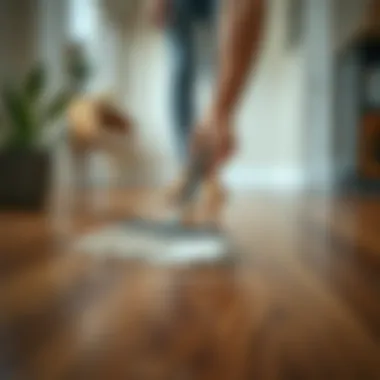
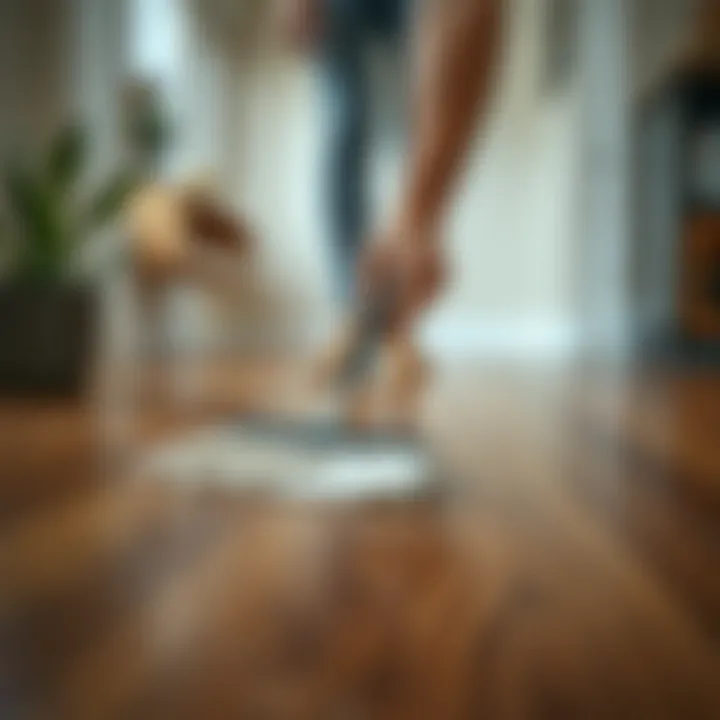
Intro
Maintaining hardwood floors is a bit of an art. The elegance they bring to a space cannot be overstated, but without proper care, their natural charm can fade fast. Dusting is one of the most essential practices that keep these floors looking pristine.
The nuances of dusting hardwood go beyond just grabbing a broom and sweeping. It’s about choosing the right tools, mastering techniques, and understanding how frequency impacts your flooring. Whether you’re prepping for a luxurious gathering or just aiming for day-to-day cleanliness, knowing the ins and outs of hardwood care is invaluable.
In this guide, we will delve deep into effective dusting methods tailored to the unique needs of hardwood, avoiding common pitfalls along the way. Furthermore, we will discuss the most suitable tools and products, ensuring you’re equipped to maintain the beauty of your floors for years to come.
Understanding Hardwood Floors
Hardwood floors are not just a surface to walk on; they are a statement about style, durability, and sophistication. The significance of understanding hardwood floors lies in recognizing their inherent characteristics, which play a pivotal role in maintaining their beauty and longevity. Choosing the right type and finish can make all the difference, especially when it comes to proper dusting and ongoing maintenance. This guide aims to not only outline the type of hardwood options available but also discuss finishes that complement your home’s design.
Types of Hardwood Floors
Solid Hardwood
Solid hardwood floors are made from a single piece of timber. This key characteristic gives them an unparalleled natural look and feel. Most importantly, solid hardwood is known for its longevity, often lasting decades with proper care. Many homeowners find this option particularly appealing due to the unique grains that each board possesses, making every floor a piece of art. However, it’s important to keep in mind that solid hardwood can warp or swell with moisture, hence proper dusting techniques are essential to avoid water accumulation during the cleaning process.
Moreover, the ability to sand and refinish solid hardwood—sometimes multiple times—gives it a significant advantage over other materials, allowing homeowners to restore its original charm when scratches and dents appear over time. This quality makes solid hardwood a favored selection for those willing to invest in durable beauty.
Engineered Hardwood
Engineered hardwood, on the other hand, is constructed with multiple layers of wood, providing stability that outmatches its solid counterpart, especially in varied humidity conditions. This makes engineered hardwood a beneficial choice for areas prone to moisture, like basements or kitchens. The top layer is crafted from real wood veneer, ensuring that the aesthetic appeal remains authentic.
A unique feature of engineered hardwood is that it can even be installed over concrete subfloors, which is a significant advantage for many homeowners and builders. This technology enhances its versatility, enabling it to marry beauty with practicality. However, while it can be sanded once or twice at best, this might deter those looking for a longer-term refinishing option compared to solid hardwood. Still, for its resilience and look, engineered hardwood stands as a popular choice.
Finishes and Coatings
Unfinished vs. Finished
When it comes to finishes, the choice between unfinished and finished wood can influence not only the appearance but also the maintenance required. An unfinished hardwood floor allows for a completely custom finish to be applied on-site, enabling homeowners to select the sheen and color that best suits their home decor.
However, unfinished wood requires careful management during the installation phase to prevent dust and grime from settling into the porous finish, as it can be problematic down the line. On the flip side, finished hardwood comes pre-coated, offering convenience at the expense of customization.
Finished floors generally stand up better to the wear and tear of everyday life, making them a popular choice for households with pets and children. They are often more resistant to scratching and spilling, which is essential when considering regular dusting and cleaning routines.
Oiling vs. Varnishing
The debate between oiling and varnishing is significant in relation to maintenance requirements and visual appearance. Oiling penetrates the wood, offering a more natural look and feel. This finish is easier to touch up because you won’t need to sand the entire floor before maintenance. However, it does require more frequent application to maintain its protective properties.
On the other hand, varnishing provides a hard, protective layer over the wood. This finish is advantageous in households demanding a resilient surface, often requiring less frequent maintenance. The downside? Once worn down, it may necessitate sanding, which can be disruptive. Understanding these distinctions in finishes and coatings allows a homeowner to make informed decisions regarding how to effectively dust and care for their hardwood floors, aiding in prolonging their life and aesthetic charm.
Why Dusting is Essential
Maintaining the charm of hardwood floors goes beyond aesthetics; it involves understanding why dusting these surfaces should be a staple in every homeowner’s routine. Dusting is vital not just for keeping the appearance of your floors polished and inviting, but it plays a crucial role in preventing potential damage and promoting overall health within your living space.
Preventing Damage
Scratches
Scratches can turn your floor from glossy to drab faster than you can say "oops." These marks often occur from daily activities—moving furniture, the casual scuff of shoes, or even the playful romp of pets through the house. The key thing to remember about scratches is that they not only detract from the beauty of your hardwood but can also lead to deeper damage over time.
It's like letting the little things slide; before you know it, those tiny scratches accumulate and create a big problem. Regular dusting helps minimize the grit and grunge that is often the culprit behind these pesky marks. By adopting a consistent dusting routine, you keep the elements that lead to scratches at bay—this way, your investment remains in tip-top shape.
The unique feature here is the preventive aspect. By staying ahead of these damaging forces, you're protecting the finish and longevity of your flooring. It's a proactive choice that pays dividends down the line.
Dullness
Another nuisance that can arise from neglecting regular care is the dreaded dullness of your floors. Over time, dust builds up and can create a film, dampening the original luster that first dazzled you. Dull hardwood isn’t just an eyesore; it also hints at underlying issues that could escalate if left unattended.
The distinct characteristic of dullness is that it often creeps up on you, subtly progressing until the vibrant hardwood you once admired is a mere shadow of its former self. Regular dusting thwarts this dulling effect, preserving the original gleam.
What’s advantageous about addressing this as part of routine care is not just the aesthetics but the way your floors reflect light, enhancing the overall ambiance of your home. A shiny floor can uplift a space dramatically, changing how it feels and looks without substantial costs involved.

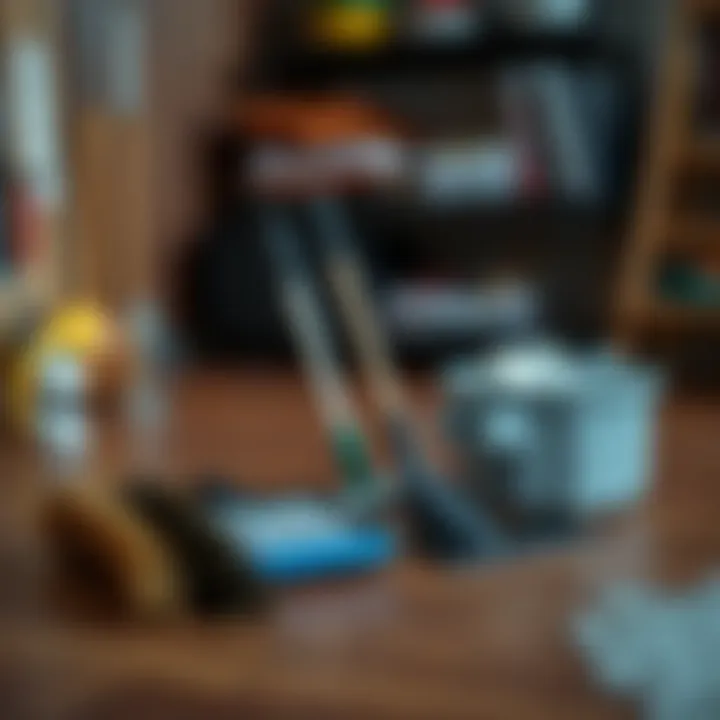
Health Benefits
Allergen Reduction
Dust isn't just an aesthetic issue; it’s also a health concern. Dust and allergens can accumulate quickly on your hardwood floors, becoming a nuisance for anyone sensitive to pollen, pet dander, or even just general household dust. By dusting regularly, you're effectively reducing these allergens significantly, making your home a healthier environment.
The notable aspect of allergen reduction is that while dusting often seems like a minor task, the value it brings in terms of comfort and well-being, particularly for those with respiratory issues or allergies, cannot be overstated. It’s a small effort that yields a big impact—you'll find yourself breathing easier in a cleaner space.
Improved Air Quality
Another remarkable benefit of maintaining a dust-free hardwood floor is the improvement in air quality. Over time, dust that settles can be stirred back up into the air, affecting everything from how you breathe to how comfortable you feel in your home. Dusting regularly contributes to a cleaner atmosphere, promoting better air circulation.
Think of it this way: your floors are often a silent contributor to indoor air quality. A clean hardwood floor supports an environment in which the air is noticeably fresher, reducing the need for excessive cleaning later.
In summary, the act of dusting hardwood floors transcends basic maintenance—it’s a protective measure against damage, enhances health, and promotes a vibrant atmosphere in any space. Regularly investing time in this essential task not only elevates your hardwood's appearance but also ensures a healthier, more enjoyable living environment.
Tools and Supplies for Dusting
When it comes to maintaining the allure and longevity of hardwood floors, having the right tools and supplies is like bringing a well-sharpened knife to a cooking competition. Dust is not just a benign nuisance; it can gradually degrade the surface of these beautiful floors if left unattended. Proper selection of your cleaning apparatus is paramount not only for effectiveness but also for protecting the investment in your flooring.
Choosing the Right Mop
The mop is your frontline soldier in the battle against dust. With multiple options available, picking the right one can make all the difference in your cleaning efforts.
Microfiber Mops
Microfiber mops stand out for their distinctive design, which allows them to attract and trap dust particles rather than simply pushing them around. Their fibers are split to create tiny hooks that hold onto dirt and dust.
Key Characteristic: The ability of microfibers to hold grit and grime is unparalleled.
This option is particularly popular because it requires less effort. Many models are also designed to be reusable, making them both eco-friendly and cost-effective over time. However, be careful not to use them on floors that are too wet, as this might cause streaking or damage.
Advantages: High efficiency, reusable, gentle on wood surfaces.
Disadvantages: May require periodic washing to maintain effectiveness.
Static Mops
Speaking of keeping dust in check, static mops exploit the principle of static electricity to cling onto dust while cleaning. They are fairly straightforward to use and can often cover larger areas quickly.
Key Characteristic: Designed to attract dust without the need for moisture, making them perfect for quick jobs.
Though convenient, static mops tend to only pick up loose dust, which means they aren't effective for tackling more significant messes. If you're in a pinch and need to do a quick sweep, they’re adequate.
Advantages: Fast, no need for cleaning solutions.
Disadvantages: Less effective on sticky or wet spills.
Other Essential Tools
While mops are crucial, they aren’t your only allies. A couple of other essential tools can enhance your dusting routine.
Broom and Dustpan
A broom and dustpan may seem rudimentary, but their role shouldn’t be underestimated. They serve as the first line of defense against large particles that can cause scratches on hardwood floors if swept away incorrectly.
Key Characteristic: Their simple yet effective method for collecting debris is unmatched.
Finding the right broom, preferably one with fine bristles, ensures that it can gather even the smallest fragments of dust. Consider mobility—multiple types feature extendable handles, making it easier to reach tricky corners. Shoddy tools can lead to clumping debris rather than proper collection.
Advantages: Inexpensive, simple to use, effective for surface cleaning.
Disadvantages: More labor-intensive than other methods.
Vacuum Cleaner with Hardwood Setting
A vacuum cleaner specifically designed for hardwood floors can be a game-changer. This kind of model typically features a powerful suction combined with rubber wheels to avoid scratching the surface.
Key Characteristic: It’s engineered to ensure that dirt is removed from the crevices without causing harm to the finish.
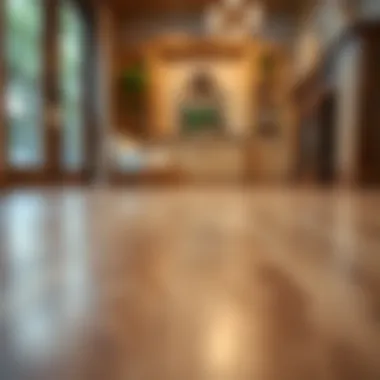
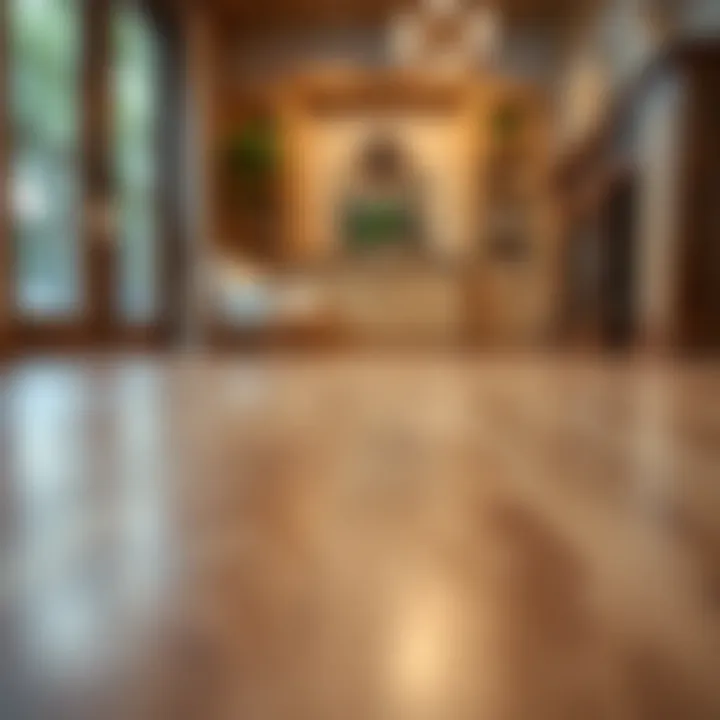
Having this kind of cleaner can save time and energy. Most vacuum cleaners today come with a variety of attachments, allowing for more thorough cleaning of various floor types as well as baseboards and corners. Just ensure it's set for hardwood use; otherwise, you might end up scratching the floor instead of cleaning it.
Advantages: Efficient removal of dirt, protects finish, versatile attachments.
Disadvantages: Can be more expensive and require maintenance.
Choosing the right tools and supplies is half the battle won in ensuring your hardwood floors remain pristine and long-lasting.
Techniques for Effective Dusting
When it comes to maintaining the elegance of hardwood floors, employing effective dusting techniques is essential. It's not just about keeping your space looking clean; it's about protecting the natural beauty and longevity of the wood itself. Knowing how to dust correctly can make a world of difference in preventing scratches and buildup that dull the finish over time. Proper techniques ensure that you’re not merely moving dust around but are truly eliminating particles that can harm your floors in the long run.
Dusting Strategies
Dry Dusting
Dry dusting is an approach favored by many because of its simplicity and efficiency. It involves using a dry cloth or a microfiber mop to capture dust and dirt without the use of additional cleaning solutions. The key characteristic of dry dusting is that it’s gentle on hardwood surfaces, reducing the risk of scratches that can easily occur with harsher methods. A big advantage of this technique is its speed; it's quick and easy to grab a microfiber cloth and run it across the floor. However, it can sometimes be less effective for sticky messes or larger debris that require a little more effort to remove.
A unique feature of dry dusting is its eco-friendliness. No chemicals are needed, making it a safer choice for households with kids and pets. Despite its benefits, users should remember that dusting should be complemented with deeper cleaning strategies from time to time to prevent grime buildup.
Using a Damp Mop Effectively
Using a damp mop effectively takes dusting up a notch by adding a layer of cleaning that dry dusting can't achieve alone. This method involves slightly wetting a mop with water or a gentle hardwood cleaner. The benefit here is that it not only picks up dust but also helps tackle stubborn spots and residues that stick to your floor. When done properly, sweeps away dirt while leaving minimal moisture behind.
The unique feature of this approach is that it accommodates various hardwood finishes, ensuring that they do not get damaged while still receiving a clean. On the flip side, over-wetting the mop can lead to water damage or warping if the floors aren’t sealed properly. Therefore, it’s crucial to strike a balance— a lightly dampened mop is the way to go.
Frequency of Dusting
The frequency of dusting plays an instrumental role in keeping hardwood floors pristine. Regularity not only maintains the appearance but also extends the life of the floors significantly. By establishing a routine, you can ensure that dirt, allergens, and dust bunnies don’t get a chance to settle in.
Daily Maintenance
Daily maintenance is particularly advantageous for households with high foot traffic or pets. By incorporating a quick dry dusting session into your everyday routine, you can prevent dirt build-up and scratches that compromise the finish of your hardwood floors. The beauty of this strategy lies in its simplicity; you can easily grab a microfiber cloth and dust for ten minutes rather than letting debris accumulate.
An important aspect of daily maintenance is the immediate attention it provides to noticeable dirt and dust. However, some may find it a chore to consistently perform, especially on busier days. Nevertheless, those few minutes can make a world of difference.
Weekly Deep Cleaning
Weekly deep cleaning is where the magic truly happens. Allocating time for this more thorough method ensures your hardwood floors are not just superficially clean but genuinely free of grime and accumulated dirt. This could include using a damp mop and a quality floor cleaner specifically designed for hardwood.
The key characteristic of weekly deep cleaning is that it provides a more comprehensive clean that cuts through layers of dust and dirt often left behind by light dusting. The unique feature is its ability to rejuvenate the wood, bringing back luster. It can also be a chance to spot-treat any issues like scuff marks or sticky areas. Although it’s a bit more labor-intensive, the benefits far outweigh the time spent. Maintaining this schedule mitigates the risk of long-term damage, ensuring your wood flooring stays beautiful and truly shines.
Remember, whether you're dry dusting, using a damp mop, performing daily, or weekly cleaning, consistency is key. The right techniques can help keep your hardwood floors looking pristine and prolong their life.
Common Mistakes to Avoid
When it comes to hardwood floors, few things can lead to costly repairs or unsightly appearances like neglecting the right practices in maintenance. Avoiding common pitfalls in dusting can make a world of difference, and knowing these mistakes can save time, effort, and money in the long run.
Using Improper Tools
Using the right tools doesn't only make cleaning easier; it also helps to protect those gorgeous hardwood surfaces. Let’s break this down.
Regular Mops vs. Microfiber
So, what’s the deal with regular mops? They might seem handy, but using them on hardwood floors can be more destructive than beneficial. While they absorb spills well, they can spread dirt and grime instead of cleaning it up properly. On the other hand, microfiber mops are often considered the go-to choice for hardwood maintenance.
The unique characteristic of microfiber is its ability to attract and hold onto dust and dirt due to its fine and plush fibers. This feature means you’re not just pushing particles around but actually lifting them off the floors — that’s a real game changer for cleaning efficacy. When utilizing microfiber mops, you'll likely notice they require less effort than their traditional counterparts. This ease of use and efficiency makes them a popular choice for homeowners and professionals alike.
Avoiding Harsh Chemicals
One major error so many make is using harsh chemicals that can strip away the finish of hardwood. Nobody wants dull, damaged floors from a ragtag cleaning routine! Opting for gentle, pH-balanced cleaners is paramount. These products are crafted to clean effectively without the harsh side effects of their aggressive counterparts.
The key thinking behind avoiding harsh chemicals is rooted in preserving your flooring’s lifespan. Chemical agents can weaken the finish and lead to premature wear. Choosing gentler solutions not only safeguards the floor’s aesthetic appeal but extends its life.
Neglecting Regular Maintenance
Regular maintenance is not just about aesthetics; it directly impacts the durability of your hardwood floors. Skipping out on this responsibility can lead to daunting consequences that are often overlooked.
Impact of Infrequent Cleaning
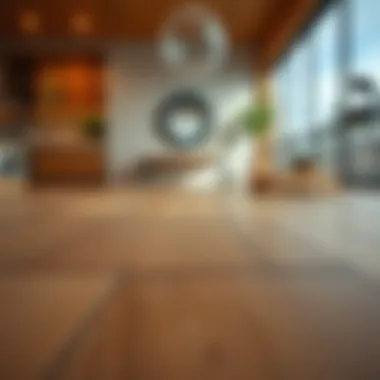
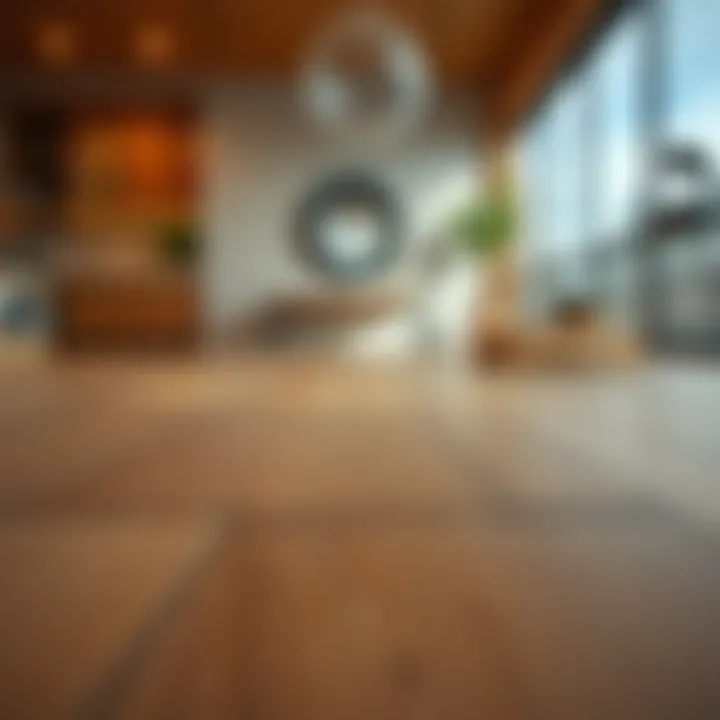
Infrequent cleaning can lead to a buildup of dust and grime, which acts like sandpaper on your hardwood. This gritty layer can scratch your floors and make them look worn out faster. Regular dusting helps in maintaining that shiny finish and protects against potential damage. If you wait too long to clean, not only will the dirt be tougher to remove, but you can also inadvertently cause irreversible damage to the flooring’s surface. Thus, adopting a consistent cleaning routine is beneficial for both immediate and long-term upkeep.
Long-term Consequences
In the grand scheme of things, the long-term consequences of neglecting regular maintenance can be hefty. From scratched finishes to faded color, the aesthetic impact is just the tip of the iceberg.
The persistent dust and dirt can compromise the structural integrity of the flooring. Over time, you might find yourself facing the prospect of refinishing or, worse, replacing sections of your beautiful hardwood. This situation can demand significant financial and time investment, which is why preventive measures are worth their weight in gold!
Remember: Regular care can mean the difference between simple cleaning and costly restorations.
The importance of proper dusting cannot be overstated. By avoiding these common mistakes, you can ensure that your hardwood floors remain a source of pride rather than a source of worry.
Additional Care Tips
Taking good care of hardwood floors means knowing the ins and outs of maintaining their charm and integrity. While dusting is vital, it’s the additional care tips that will really make your hardwood shine and stand the test of time. Implementing simple strategies, such as utilizing area rugs and protecting high-traffic areas, can significantly reduce wear and tear, ensuring that floors remain as stunning as the day they were installed.
Utilizing Area Rugs
Area rugs can be a game-changer when it comes to preserving the beauty of hardwood floors. When placed correctly, they serve multiple purposes—from adding style to absorbing foot traffic.
Placement Strategies
The placement of area rugs is crucial in keeping floors protected. Positioning them in high-traffic zones, like entryways or beneath dining tables, is an effective move. Rugs act as a barrier, catching dirt and debris before it has a chance to scratch or dull the wood surface. Furthermore, it’s wise to leave enough space around the edges of the rug to minimize fraying and allow the floor to breathe. This strategy aids in maintaining not only the floor’s condition but also its aesthetic appeal. However, it’s important to ensure the rugs are anchored well to avoid tripping hazards.
Placement matters because it facilitates a balance between functionality and style, which can elevate the entire room’s atmosphere.
Material Choices
Choosing the right material for area rugs can also make a significant difference. Natural fibers like wool or cotton are often recommended. These materials not only bring warmth but are also durable and easy to clean, making them practical choices. Synthetic options, like nylon or polyester, can also work wonders, as they often come with stain resistance, which is a real lifesaver in busy households. However, it’s good to be mindful that some synthetics might not be as breathable. So, it’s a balancing act between durability and maintaining the look of the wood underneath.
Protecting High-Traffic Areas
High-traffic areas deserve special attention. These spots—the living room, hallways, and around kitchen islands—tend to wear down faster due to constant movement.
Furniture Pads
One of the smartest ways to protect hardwood is by using furniture pads. These small cushions stick to the bottom of chair and table legs, reducing friction when moved. The key characteristic of these pads is that they can be made from various materials, including felt or rubber, each providing different levels of protection. By using furniture pads, you can drastically cut down on scratches and keep your floors looking pristine longer.
Additionally, they are easy to install, making it a simple upgrade for any home.
Regular Rotation of Area Rugs
The idea of regularly rotating area rugs may seem trivial, but it’s a significant factor in extending both the life of the rugs and the floor beneath them. By moving rugs around, you avoid uneven wear patterns due to foot traffic and sunlight fading. It’s advisable to rotate rugs every few months.
The unique feature here is the versatility it offers—ensuring that any fading is distributed evenly across the rug’s surface. This not only keeps the rugs looking fresh longer but also helps in protecting the hardwood from becoming unevenly worn. The practice of rotation demonstrates a mindful approach to care, fitting well within the larger framework of hardwood maintenance.
"A little bit of prevention goes a long way in preserving the elegance of your hardwood floors."
By implementing these additional care tips, you can enhance your hardwood experience, ensuring that your floors do not just age gracefully but remain a top highlight of your home.
Ending
Maintaining hardwood floors is a commitment, one where the benefits resonate far beyond mere aesthetics. As outlined throughout this guide, regular dusting is essential for not only preserving the visual charm of your wood but also extends its lifespan significantly. When you engage in consistent care practices, the result is a living space that exudes elegance and comfort, creating a refined atmosphere that complements your lifestyle.
Summary of Key Practices
In summary, a few key practices stand out when caring for hardwood floors:
- Choose the Right Tools: A microfiber mop or a static mop is vital for effectively capturing dust and dirt without causing scratches. Always opt for tools specifically designed for hardwood surfaces, steering clear of traditional mops that retain moisture.
- Establish a Regular Schedule: Dust frequently, ideally daily or every few days, depending on your household activity. Consider a weekly deep cleaning to remove built-up dust and dirt.
- Utilize Area Rugs Wisely: Area rugs can greatly mitigate dust accumulation. Placing them strategically, particularly in high-traffic areas, helps protect your hardwood floors while adding an aesthetic layer.
- Be Cautious with Cleaning Solutions: Avoid harsh chemicals and stick to products designed for hardwood. This will prevent unwanted damage and maintain the finish of your floors.
Implementing these simple yet effective strategies will lead to optimal care of your hardwood floors, ensuring they remain spectacular for years.
Long-term Benefits of Proper Dusting
The long-term benefits of efficient dusting should not be underestimated. By adhering to a routine care regimen, you’ll notice:
- Enhanced Durability: Regular dusting drastically reduces the likelihood of scratches and dullness, allowing wood grain to shine. This leads to a longer-lasting surface.
- Healthier Indoor Environment: Dust accumulation can exacerbate allergies. Regular dusting minimizes allergens in your home, cultivating a clean and inviting space.
- Cost Savings: Prevention is always cheaper than repair. By taking proper care, you avoid the high cost of refinishing or replacing your hardwood floors.
Regular maintenance cultivates not just beauty but also longevity, a crucial consideration for classy home environments.
By understanding these facets, you'll appreciate the value of consistency in your hardwood maintenance practices. Armed with knowledge, every decision—from cleaning frequency to tool choice—becomes fuel for a polished, enduring elegance in your home. For more detailed guidelines, feel free to explore resources like Britannica or Wikipedia for a deeper dive into hardwood care.







